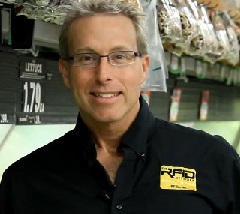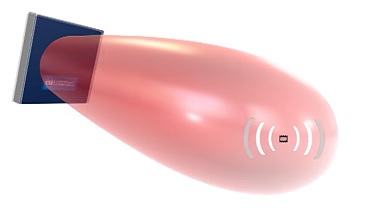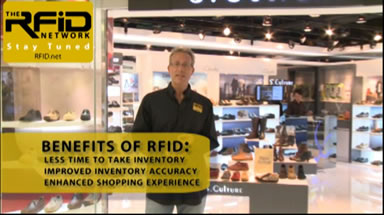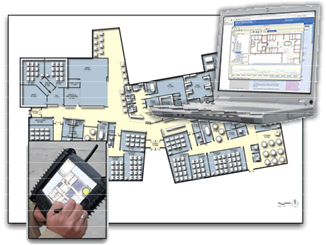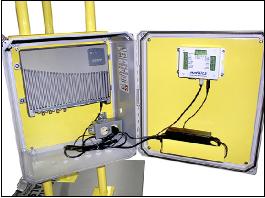
Acrylonitrile butadiene styrene (ABS) is a thermoplastic used to make light, rigid, molded enclosures. One of the most common ABS products is Legoâ„¢ building blocks. There are RFID tags that are encased in ABS to improve impact resistance, toughness, and water/heat resistance. ABS products are typically given a NEMA or IP rating for durability.
NEMA (National Electrical Manufacturers Association) has established a range of standards for electrical equipment enclosures.
The IP (Ingress Protection or International Protection) Rating is defined in international standard IEC (International Electrotechnical Commission) 60529.
Both rating systems classify the degrees of protection provided by enclosures for electrical equipment against external influences or conditions such as:
- mechanical impacts
- contact with hazardous moving parts external to the enclosure (such as fans)
- moisture (for example, produced by condensation )
- corrosion
- corrosive solvents (for example, cutting liquids)
- fungus
- vermin
- solar radiation
- icing
- explosive atmospheres
NEMA Ratings
Here is a partial list of the NEMA standards used in industrial environments:
NEMA 4 - Type 4 enclosures are intended for indoor or outdoor use primarily to provide a degree of protection against windblown dust and rain, splashing water, and hose-directed water; and to be undamaged by the formation of ice on the enclosure. They are not intended to provide protection against conditions such as internal condensation or internal icing.
NEMA 4X - Type 4X enclosures are intended for indoor or outdoor use primarily to provide a degree of protection against corrosion, windblown dust and rain, splashing water, and hose-directed water; and to be undamaged by the formation of ice on the enclosure. they are not intended to provide protection against conditions such as internal condensation or internal icing.
NEMA 12 - Type 12 enclosures are intended for indoor use primarily to provide a degree of protection against circulating dust, falling dirt, and dripping none corrosive liquids. They are not intended to provide protection against such conditions as internal condensation.
NEMA 13 -Type 13 enclosures are intended for indoor use primarily to provide a degree of protection against lint, dust, spraying of water, oil and none corrosive coolant. They are not intended to provide protection against conditions such as internal condensation.
IP Ratings
An IP Rating consists of the letters IP followed by two digits and an optional letter.
First digit
The first digit indicates the level of protection that the enclosure provides against access to hazardous parts (e.g., electrical conductors, moving parts) and the ingress of solid foreign objects.
| Level | Object size protected against | Effective against |
|---|---|---|
| 0 | — | No protection against contact and ingress of objects |
| 1 | >50 mm | Any large surface of the body, such as the back of a hand, but no protection against deliberate contact with a body part |
| 2 | >12.5 mm | Fingers or similar objects |
| 3 | >2.5 mm | Tools, thick wires, etc. |
| 4 | >1 mm | Most wires, screws, etc. |
| 5 | dust protected | Ingress of dust is not entirely prevented, but it must not enter in sufficient quantity to interfere with the satisfactory operation of the equipment; complete protection against contact |
| 6 | dust tight | No ingress of dust; complete protection against contact |
Second digit
Protection of the equipment inside the enclosure against harmful ingress of water.
| Level | Protected against | Details |
|---|---|---|
| 0 | not protected | — |
| 1 | dripping water | Dripping water (vertically falling drops) shall have no harmful effect. |
| 2 | dripping water when tilted up to 15° | Vertically dripping water shall have no harmful effect when the enclosure is tilted at an angle up to 15° from its normal position. |
| 3 | spraying water | Water falling as a spray at any angle up to 60° from the vertical shall have no harmful effect. |
| 4 | splashing water | Water splashing against the enclosure from any direction shall have no harmful effect. |
| 5 | water jets | Water projected by a nozzle against enclosure from any direction shall have no harmful effects. |
| 6 | powerful water jets | Water projected in powerful jets against the enclosure from any direction shall have no harmful effects. |
| 7 | immersion up to 1 m | Ingress of water in harmful quantity shall not be possible when the enclosure is immersed in water under defined conditions of pressure and time (up to 1 m of submersion). |
| 8 | immersion beyond 1 m | The equipment is suitable for continuous immersion in water under conditions which shall be specified by the manufacturer. |
Additional letters
The standard defines additional letters that can be appended to classify only the level of protection against access to hazardous parts by persons:
| Level | Protected against access to hazardous parts with |
|---|---|
| A | back of hand |
| B | finger |
| C | tool |
| D | wire |
Further letters can be appended to provide additional information related to the protection of the device:
| Letter | Meaning |
|---|---|
| H | high voltage device |
| M | device moving during water test |
| S | device standing still during water test |
| W | weather conditions |
Mechanical impact resistance
An additional number has sometimes been used to specify the resistance of equipment to mechanical impact. This mechanical impact is identified by the energy needed to qualify a specified resistance level, which is measured in joules (J). This has now been superseded by the separate IK number specified in EN 62262.
Although dropped from the 3rd edition of IEC 60529 onwards, and not present in the EN version, older enclosure specifications will sometimes be seen with an optional third IP digit denoting impact resistance. Newer products are likely to be given an IK rating instead. However there is not an exact correspondence of values between the old and new standards.
| Dropped IP level | Impact energy | Equivalent drop mass and height |
|---|---|---|
| 0 | — | — |
| 1 | 0.225Â J | 150Â g dropped from 15Â cm |
| 2 | 0.375Â J | 250Â g dropped from 15Â cm |
| 3 | 0.5Â J | 250Â g dropped from 20Â cm |
| 5 | 2Â J | 500Â g dropped from 40Â cm |
| 7 | 6Â J | 1.5Â kg dropped from 40Â cm |
| 9 | 20Â J | 5.0Â kg dropped from 40Â cm |
| IK number | Impact energy (joules) | Equivalent impact |
|---|---|---|
| 00 | Unprotected | No test |
| 01 | 0.15 | Drop of 200Â g object from 7.5Â cm height |
| 02 | 0.2 | Drop of 200Â g object from 10Â cm height |
| 03 | 0.35 | Drop of 200Â g object from 17.5Â cm height |
| 04 | 0.5 | Drop of 200Â g object from 25Â cm height |
| 05 | 0.7 | Drop of 200Â g object from 35Â cm height |
| 06 | 1 | Drop of 500Â g object from 20Â cm height |
| 07 | 2 | Drop of 500Â g object from 40Â cm height |
| 08 | 5 | Drop of 1.7Â kg object from 29.5Â cm height |
| 09 | 10 | Drop of 5Â kg object from 20Â cm height |
| 10 | 20 | Drop of 5Â kg object from 40Â cm height |
IPX Coding =
The letter X is used in any place in the code where specifying a digit is meant to be avoided. There may be various reasons for choosing this coding variant, such as marketing considerations. Thus, e.g. an IPX7 rating for a consumer device specifies that the device has water protection up to limited immersion, but gives deliberately no information as to whether the device has any protection against mechanical ingress or dust. Among other common IP ratings using the letter X are IPX4.
IP69K
German standard DIN 40050-9 extends the IEC 60529 rating system described above with an IP69K rating for high-pressure, high-temperature wash-down applications. Such enclosures must not only be dust tight (IP6X), but also able to withstand high-pressure and steam cleaning.
The test specifies a spray nozzle that is fed with 80°C water at 8–10MPa (80–100bar) and a flow rate of 14–16L/min. The nozzle is held 10–15 cm from the tested device at angles of 0°, 30°, 60° and 90° for 30s each. The test device sits on a turntable that rotates once every 12s (5rpm).
The IP69K test specification was initially developed for road vehicles, especially those that need regular intensive cleaning (dump trucks, cement mixers, etc.), but also finds use in other areas (e.g., food industry, car wash centres).

